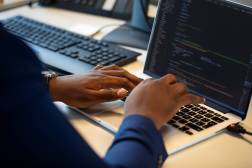Move to remote learning was ‘shockingly seamless,’ but will it stick?

The coronavirus pandemic has in recent months forced universities through a logistical and managerial obstacle course, but two university technology leaders said Thursday that their institutions have managed to adapt surprisingly well, though the future of remote learning remains unclear.
Paige Francis, the chief information officer of the University of Tulsa, a private institution of 4,500 students in the northeastern corner of Oklahoma, said her faculty, students and staff were supplied with all the equipment and resources they needed via a “shockingly seamless” process. Though, she admitted, the smooth transition from in-person instruction to a work-at-home paradigm can be attributed at least in part to a fortuitous mistake.
“I accidentally ordered everything that we needed twice,” Francis said during a webcast hosted by Scoop News Group. “So I ordered a whole shipment of laptops and iPads and webcams and I forgot I did it, so I reordered all of it that afternoon. And so we had all of the supplies we needed.”
Many other other universities, businesses and government agencies have struggled in recent weeks to get the equipment they needed as hitches in the global supply chain have led to shortages of laptops and other essential office equipment. California State University system CIO Michael Berman said that ensuring students have had continued access to educational resources, particularly students learning from home in rural areas of the state, has been a continual challenge.
“We also have a student body that has a lot of financial challenges,” Berman said. “We know that in a given year, a number of our students will be struggling with finding a place to sleep or having food security. So suddenly telling them they need a good quiet place to work with a computer and online access was not easy to come by for all our students.”
To help the 23-campus system’s approximately 480,000 students stay connected during the pandemic, Berman said it distributed more than 5,000 laptops and “thousands” of Wi-Fi hotspots. (Access to education has proven an increasingly urgent national issue at all grade levels; draft legislation submitted to Congress on Thursday would direct $5.25 billion to ensure internet connectivity for K-12 students learning from home.)
Beyond access, institutions have also struggled with new cybersecurity challenges associated with remote learning. Berman admitted that “there probably wasn’t a whole lot of thinking about cybersecurity” during CSU’s transition to remote learning because of the limited time available. But higher education’s cybersecurity posture was relatively well-suited for a pandemic, he said, in that the typical cybersecurity model adopted by universities doesn’t assume users are working from fixed locations.
“In higher education, we assume everywhere is a hostile environment already and we’re trying to build security structures that work that way,” Berman said. “We may not always be successful, but I think at least we’ve been in that world that a lot of people are going to.”
In yet another stroke of luck at the University of Tulsa, Francis said her office had planned to launch a new multi-factor authentication capability the week before the pandemic hit, but some administrative uncertainty unrelated to the health crisis had delayed its launch. Though multi-factor authentication might have proven useful for what would soon be a more distributed workforce and student body, she said it fortunate her office wasn’t required to monitor the release of a new security product on top of what would soon prove to be a busy and confusing period. But as it happened, things went smoothly, she said.
“We were really as prepared as we could be from a security standpoint,” Francis said. “It was not a piece that worried me too much because it really should be something that’s folded into the fabric of your everyday … even though we noticed an immediate 1,000 percent increase in attempted attacks within two weeks of going remote.”
After the pandemic, Francis predicted that universities will become even more “location-fluid” than they are today, noting that even faculty members who were previously “so staunchly anti-online that it hurts” have now shown interest in remote learning. Berman was more bearish on the prospect of willfully prolonging social distancing, noting that many students and faculty were “very unhappy” with the change.
“We know that well-designed, well-planned and well-thought-out online education offered by a trained faculty member and prepared student can be incredibly effective, that’s not mostly what happened. This was emergency, contingent, best-effort teaching,” he said. “I do think there’s going to be a kind of great reckoning coming about what is the right role of remote teaching?”
This story is part of StateScoop & EdScoop’s Special Report on Remote Workforce.




